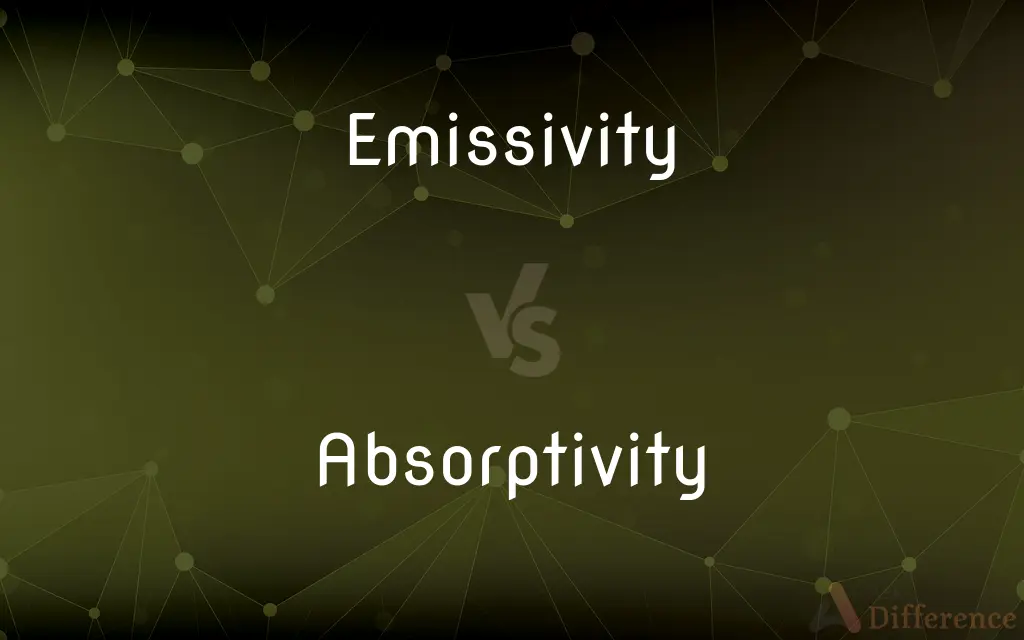Emissivity vs. Absorptivity — What's the Difference?
Edited by Tayyaba Rehman — By Fiza Rafique — Updated on April 4, 2024
Emissivity measures a material's ability to emit thermal radiation, while absorptivity quantifies how well it absorbs thermal radiation. Both properties affect thermal management but in opposite phases of energy exchange.

Difference Between Emissivity and Absorptivity
Table of Contents
ADVERTISEMENT
Key Differences
Emissivity is a material's effectiveness in emitting energy as thermal radiation compared to a perfect black body, which is considered to have an emissivity of 1. This property is crucial in determining how a material cools down by radiating heat away. On the other hand, absorptivity measures a material's capacity to absorb thermal radiation from its surroundings, influencing how it heats up. High absorptivity means a material can efficiently absorb heat, making it warmer over time.
Materials with high emissivity are excellent at both emitting and absorbing thermal radiation due to Kirchhoff's law of thermal radiation, which states that emissivity and absorptivity ratios are equal at thermal equilibrium for a given wavelength. However, while emissivity is often discussed in the context of a material cooling down by emitting heat, absorptivity is considered in the context of heating up a material by absorbing external radiation.
In practical applications, the choice between materials with different emissivities and absorptivities depends on the desired thermal management outcome. For instance, materials with high emissivity and absorptivity are preferred for solar absorber panels to maximize heat absorption and retention. Conversely, materials with low emissivity are used in thermal insulation to prevent heat loss.
The measurement of emissivity and absorptivity can vary depending on several factors, including the material's temperature, surface finish, and the wavelength of the thermal radiation. These properties are not constants and can change based on these conditions, making it crucial to consider the specific context when evaluating a material's thermal behavior.
Understanding the balance between emissivity and absorptivity is essential in fields such as climatology, building design, and materials science, where controlling temperature and heat flow is crucial. By selecting materials with appropriate emissivity and absorptivity values, engineers and scientists can design systems that maintain desired temperatures more efficiently.
ADVERTISEMENT
Comparison Chart
Definition
Ability to emit thermal radiation
Ability to absorb thermal radiation
Relative to
Perfect black body (emissivity = 1)
Incoming thermal radiation
Influences
Cooling by radiation
Heating by absorbing radiation
Kirchhoff's Law
Equal to absorptivity at thermal equilibrium
Equal to emissivity at thermal equilibrium
Dependence
Material, temperature, surface, wavelength
Material, temperature, surface, wavelength
Compare with Definitions
Emissivity
Dependent on factors like material composition, surface finish, and temperature.
The emissivity of a surface can increase with roughening.
Absorptivity
A material's capacity to absorb thermal radiation from its environment.
Dark-colored materials have higher absorptivity, making them warmer in sunlight.
Emissivity
A measure of a material's ability to emit thermal radiation relative to a perfect black body.
The emissivity of polished silver is much lower than that of asphalt.
Absorptivity
Essential for applications requiring efficient heat absorption, such as solar water heaters.
Solar absorbers are selected for their high absorptivity to maximize energy capture.
Emissivity
The ratio of the thermal radiation emitted by a surface to the radiation emitted by a black body at the same temperature.
Materials with high emissivity are used in space to dissipate heat.
Absorptivity
The proportion of incident thermal radiation that a material absorbs rather than reflecting or transmitting.
A material's absorptivity affects its efficiency as a solar panel.
Emissivity
A critical factor in thermal imaging and temperature measurements.
Thermal cameras are calibrated to consider the emissivity of different materials.
Absorptivity
Varies with the wavelength of incoming radiation, making it specific to certain types of energy.
Glass has high absorptivity for UV light but is transparent to visible light.
Emissivity
A property that influences how efficiently a surface cools itself by emitting infrared radiation.
Engineers consider emissivity when designing thermal insulation.
Absorptivity
Influenced by the material's color, texture, and molecular composition.
Absorptivity is a key consideration in designing energy-efficient buildings.
Emissivity
The emissivity of the surface of a material is its effectiveness in emitting energy as thermal radiation. Thermal radiation is electromagnetic radiation that may include both visible radiation (light) and infrared radiation, which is not visible to human eyes.
Absorptivity
The act or process of absorbing or the condition of being absorbed.
Emissivity
(physics) The energy-emitting propensity of a surface, usually measured at a specific wavelength.
Absorptivity
A state of mental concentration.
Emissivity
The ratio of the radiation emitted by a surface to the radiation emitted by a blackbody at the same temperature.
Absorptivity
The quality of being absorptive; absorptiveness.
Emissivity
Tendency to emission; comparative facility of emission, or rate at which emission takes place;
Absorptivity
(thermodynamics) The fraction of radiation absorbed by a surface to the total radiation incident on the surface.
Absorptivity
(analytical chemistry) The constant a in the Beer's law relation A = abc, where A is the absorbance, b the path length, and c the concentration of solution. Also known as absorptive power. Formerly known as absorbency index; absorption constant; extinction coefficient.
Absorptivity
Absorptiveness.
Absorptivity
(physics) the property of a body that determines the fraction of the incident radiation or sound flux absorbed or absorbable by the body
Common Curiosities
Can a material have high emissivity and high absorptivity at the same time?
Yes, according to Kirchhoff's law, at thermal equilibrium, a material's emissivity and absorptivity are equal for a given wavelength, meaning a material can have both high emissivity and high absorptivity.
Can the emissivity of a material change over time?
Yes, a material's emissivity can change due to factors like aging, surface degradation, or changes in surface finish, affecting its thermal radiation properties.
What is the main difference between emissivity and absorptivity?
Emissivity is a material's ability to emit thermal radiation, while absorptivity is its capacity to absorb thermal radiation.
Is it better to have higher or lower emissivity for outdoor materials?
The ideal emissivity depends on the application; high emissivity is beneficial for cooling, while low emissivity is preferred for insulation to reduce heat loss.
How do emissivity and absorptivity affect a building's climate control?
Materials with appropriate emissivity and absorptivity values are crucial for managing a building's heating and cooling, influencing energy efficiency and indoor comfort.
Why is emissivity important in thermal insulation?
Materials with low emissivity are important in thermal insulation because they emit less thermal radiation, helping to prevent heat loss from a structure.
How do engineers use emissivity and absorptivity in designing solar panels?
Engineers select materials with high absorptivity for sunlight and appropriate emissivity to ensure solar panels absorb maximum solar energy while managing their temperature.
Are emissivity and absorptivity only relevant to heat?
While primarily related to thermal radiation (heat), the concepts can extend to other types of electromagnetic radiation depending on the context, but they are most commonly associated with heat transfer.
Do all materials have the same emissivity and absorptivity for all wavelengths of radiation?
No, emissivity and absorptivity vary with wavelength; a material can have different values at different wavelengths, affecting its interaction with various types of radiation.
How are emissivity and absorptivity measured?
Emissivity and absorptivity are measured using spectrometers and calorimeters, which can quantify how much radiation a material emits or absorbs compared to a reference.
Share Your Discovery

Previous Comparison
Antechamber vs. Chamber
Next Comparison
Modern vs. TrendyAuthor Spotlight
Written by
Fiza RafiqueFiza Rafique is a skilled content writer at AskDifference.com, where she meticulously refines and enhances written pieces. Drawing from her vast editorial expertise, Fiza ensures clarity, accuracy, and precision in every article. Passionate about language, she continually seeks to elevate the quality of content for readers worldwide.
Edited by
Tayyaba RehmanTayyaba Rehman is a distinguished writer, currently serving as a primary contributor to askdifference.com. As a researcher in semantics and etymology, Tayyaba's passion for the complexity of languages and their distinctions has found a perfect home on the platform. Tayyaba delves into the intricacies of language, distinguishing between commonly confused words and phrases, thereby providing clarity for readers worldwide.














































